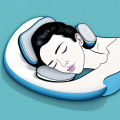If you’ve ever experienced neck and shoulder pain, it’s possible that you may have trapezius trigger points. These are tight knots that form in the upper back muscles, resulting in pain and discomfort. Fortunately, you can release these trigger points using a simple tool you may already have at home: a tennis ball. In this article, we’ll explore the underlying causes of trigger points, the symptoms of trapezius trigger points, the benefits of using a tennis ball for trigger point release, and how to correctly perform the self-massage technique with a tennis ball.
Understanding Trigger Points and Their Causes
Trigger points are essentially tight knots that form in muscles, often resulting from overuse, injury, or stress. The knots can compress nerves and cause pain, which may radiate to other areas of the body. Trigger points can be acute or chronic, and are often associated with myofascial pain syndrome. Common causes of trigger points include poor posture, repetitive movements, poor ergonomics, and muscular imbalances.
In addition to these common causes, trigger points can also be caused by emotional stress and tension. When we experience stress, our muscles tend to tense up, which can lead to the formation of trigger points. This is why trigger points are often found in areas of the body that are prone to tension, such as the neck, shoulders, and upper back. It’s important to address both the physical and emotional causes of trigger points in order to effectively manage and prevent them.
Symptoms of Trapezius Trigger Points
Trapezius trigger points often result in neck and shoulder pain, as well as headaches. The pain may be sharp or dull, and may radiate from the neck and shoulders down the arms. There may also be muscle stiffness or a decreased range of motion in the neck and shoulders.
In addition to the physical symptoms, trapezius trigger points can also cause emotional distress. Chronic pain can lead to anxiety, depression, and difficulty sleeping. It is important to seek treatment for trigger points to not only alleviate physical pain, but also improve overall well-being.
Benefits of Using a Tennis Ball for Trigger Point Release
Using a tennis ball for trigger point release is a simple and inexpensive method that can be done at home. It can effectively release muscle tension, reduce pain, and increase range of motion. By applying pressure to the affected area, blood flow is increased, and the tight knots are broken up. Additionally, using a tennis ball can be a great way to relax after a long day at work.
Another benefit of using a tennis ball for trigger point release is that it can be used to target specific areas of the body. For example, if you have tightness in your shoulders, you can place the tennis ball between your shoulder blade and spine and roll it around to release the tension. This targeted approach can be more effective than a general massage, as it allows you to focus on the areas that need the most attention.
Preparing for the Self-Massage with a Tennis Ball
Before beginning the self-massage with a tennis ball, it’s important to properly prepare your body. Start by finding a quiet and comfortable space where you won’t be disturbed. Warm up your muscles by taking a warm shower or using a heating pad on the affected area. Make sure to stay hydrated, and avoid using a tennis ball on any areas of the skin that are sensitive or inflamed.
It’s also important to take your time and listen to your body during the self-massage. Don’t apply too much pressure or force, and stop immediately if you experience any pain or discomfort. Remember to breathe deeply and relax your muscles as you work through any knots or tension. After the self-massage, take a few minutes to rest and allow your body to fully absorb the benefits of the massage.
Identifying the Trigger Points in the Trapezius Muscle
The trapezius muscle is a large muscle that runs from the neck and upper back down to the shoulder blades. To identify the trigger points in this muscle, stand facing a wall and place a tennis ball between the wall and your trapezius muscle. Move your body so that the tennis ball rolls over the muscle, paying attention to any areas that feel particularly tender or painful.
Trigger points in the trapezius muscle can cause a variety of symptoms, including headaches, neck pain, and limited range of motion in the shoulders. If you identify trigger points in your trapezius muscle, you can use self-massage techniques or seek the help of a professional massage therapist to release the tension and alleviate the associated symptoms. It is important to address trigger points in the trapezius muscle promptly to prevent the development of chronic pain and discomfort.
The Correct Technique for Applying Pressure with a Tennis Ball
To apply pressure with a tennis ball, place the ball on the trigger point and hold it in place with gentle pressure for about 30 seconds. You can adjust the amount of pressure by leaning into the wall, or by using your other hand to apply pressure to the ball. Remember to breathe deeply and relax your body as you apply pressure. Repeat this process with any other trigger points you may have.
It is important to note that applying too much pressure or holding the ball in one spot for too long can cause discomfort or even injury. Start with light pressure and gradually increase as needed. If you experience any pain or discomfort, stop immediately and consult a healthcare professional. Additionally, using a tennis ball for self-massage should not replace professional medical treatment for any underlying conditions or injuries.
Tips and Tricks for Effective Trigger Point Release with a Tennis Ball
Some helpful tips for effective trigger point release with a tennis ball include using a foam roller or massage ball to warm up your muscles before using the tennis ball, and combining the tennis ball technique with stretches and exercises that target the trapezius muscle. Additionally, it’s important to listen to your body and avoid over-exerting yourself when performing the tennis ball technique.
How Often Should You Use the Tennis Ball Method?
The frequency with which you use the tennis ball technique depends on the severity of your trapezius trigger points. It’s generally safe to use the technique daily, but be sure to listen to your body and avoid overdoing it. If you experience any pain or discomfort while performing the technique, stop and consult with a healthcare professional.
Other Techniques for Relieving Trapezius Muscle Pain and Tension
In addition to using a tennis ball, there are other techniques for relieving trapezius muscle pain and tension. These include massage therapy, physical therapy, acupuncture, and chiropractic care. It’s important to identify the underlying cause of your trapezius trigger points and to work with a trusted healthcare professional to find the best treatment plan for your individual needs.
In conclusion, releasing trapezius trigger points with a tennis ball is a simple and effective technique that can be done at home. By understanding the underlying causes of trigger points, identifying the symptoms of trapezius trigger points, and following the correct technique for applying pressure with a tennis ball, you can effectively reduce muscle tension, decrease pain, and improve your overall quality of life.





